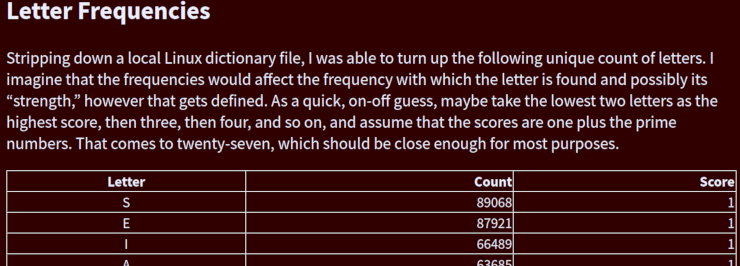Developer Journal, Early April, Minus the Fools
This has been another hectic week, including such fast-paced projects as cleaning the washing machine, so this is another light result, especially when I decided to mess around with Miniboost to improve the tool I promised myself wasn’t going to be a permanent project.

Board Game Experiments
I needed to upgrade a couple of libraries. Unfortunately, I didn’t get much else accomplished. Although I stumbled across another germ of an idea that might be worth elaborating on.
Copyright Renewal Database
Something similar goes for RenewDB, a project that I honestly forgot about after just barely starting and should probably get back to. I believe that I stopped because Bicker had a slightly steeper learning curve for a lot of the same technologies and was more interesting. But I still do want an easy search for copyright renewals.
Miniboost
Once again, I needed to upgrade a couple of libraries, and there’s one still outstanding, buried in the dependencies. However, working with this as my (almost) full-time note application for a week, I also added a couple of new features that are fairly useful for my routine work:
- To compensate for the lack of search/replace, Miniboost now scans the current note file for changes, so that complicated editing can be handled in another application. If such a change is detected, we display a button to reload that note to get the latest version. It’s not ideal, but works well enough for now.
- For easier reading, especially until word wrap is available, there is now a View in Browser button that converts the mote to HTML and opens that output in the default web browser. If you need the HTML output, Miniboost exports them into files named
Miniboost-*.htmlin the user’s temporary directory, such as/tmpon UNIX-like systems.
I also added another configuration option for the default font size (fontSize), since somebody did request it, and an option to store CSS for the exported HTML (exportStyle), since the default styling is not much of an improvement, reading-wise, from just scrolling back and forth in Miniboost. My export style looks like this, minus the white-space, in case it inspires anybody to mess around.
body {
background-color: #300000;
color: #eeeeff;
font-size: 14pt;
margin-left: 25%;
width: 50%;
}
table {
border-collapse: collapse;
width: 100%;
}
td,th {
border: 1px solid white;
}
So an example note (a small part of a weird word-game project I might get around to, one day) looks like this.

It’s a decent start, at least. I can live with that.
And now that I’ve realized that I can hide and show controls on demand (the first new feature), it might also be reasonable to create an internal search/replace feature. Probably not, since I don’t think I’ve seen any way to include keyboard accelerators to activate such a thing, but maybe. As it stands, that’s really the only significant outstanding feature that I need. Search would be nice, too, but I suspect that it’s non-trivial to change the position of the caret.
Next
For the coming week, I made a discovery this week that might make for an interesting Bicker feature, so I want to kick that around. Now that Miniboost provides a decent template for structuring a Proton Native project, this might be a good week to look at a twtxt client.
I also have one or two more things I still want to change in Miniboost, but I’m hoping that they won’t take up too much of the week.
Credits: The header image is untitled by Lotteszka from PxHere, made available under the CC0 1.0 Universal Public Domain Dedication.
No webmentions were found.
By commenting, you agree to follow the blog's Code of Conduct and that your comment is released under the same license as the rest of the blog. Or do you not like comments sections? Continue the conversation in the #entropy-arbitrage chatroom on Matrix…
Tags: programming project devjournal John Colagioia
John Colagioia